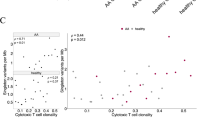Summary:
Aplastic anemia (AA) is a rare disease with a major autoimmune pathogenetic component. CTLA4 is a T-lymphocyte surface molecule involved in the maintenance of immune tolerance. Some polymorphisms associated with a reduced expression of CTLA4, and thus presumably with increased tendency to autoimmunity, have been associated with various autoimmune diseases. In this study, we evaluated the distribution of the low expression polymorphisms −318C>T and 49A>G of CTLA4 in a population of 67 patients with acquired AA and in 100 normal controls. There was no difference in the distribution of the tested polymorphism between patients and controls and, within the patient group, between those who responded to immunosuppression vs those who did not respond. This study indicates that the polymorphisms −318C>T and 49A>G of CTLA4 do not affect the risk of developing AA and do not influence the response to immunosuppression.
This is a preview of subscription content, access via your institution
Access options
Subscribe to this journal
Receive 12 print issues and online access
$259.00 per year
only $21.58 per issue
Buy this article
- Purchase on Springer Link
- Instant access to full article PDF
Prices may be subject to local taxes which are calculated during checkout

Similar content being viewed by others
References
Dufour C, Corcione A, Svahn J et al. Interferon gamma and tumour necrosis factor alpha are overexpressed in bone marrow T lymphocytes from paediatric patients with aplastic anaemia. Br J Haematol 2001; 115: 1023–1031.
Kagan WA, Ascensao JA, Pahwa RN et al. Aplastic anemia: presence in human bone marrow of cells that suppress myelopoiesis. Proc Natl Acad USA 1976; 73: 2890–2894.
Nakao S, Yamaguchi M, Shiobara S et al. Interferon gamma gene expression in unstimulated bone marrow mononuclear cells predicts a good response to cyclosporine therapy in aplastic anemia. Blood 1992; 79: 2532–2535.
Bacigalupo A, Brand R, Oneto R et al. Treatment of acquired severe aplastic anemia: bone marrow transplantation compared with immunosuppressive therapy – The European Group for Blood and Marrow Transplantation experience. Semin Hematol 2000; 37: 69–80.
Ligers A, Teleshova N, Masterman T et al. CTLA-4 gene expression is influenced by promoter and exon 1 polymorphisms. Genes Immun 2001; 2: 145–152.
Maurer M, Loserth S, Kolb-Maurer A et al. A polymorphism in the human cytotoxic T-lymphocyte antigen 4 (CTLA4) gene (exon 1 +49) alters T-cell activation. Immunogenetics 2002; 54: 1–8.
Chistiakov DA, Turakulov RI . CTLA-4 and its role in autoimmune thyroid disease. J Mol Endocrinol 2003; 31: 21–36.
Kantarci OH, Hebrink DD, Achenbach SJ et al. CTLA4 is associated with susceptibility to multiple sclerosis. J Neuroimmunol 2003; 134: 133–141.
Ueda H, Howson JM, Esposito L et al. Association of the T-cell regulatory gene CTLA4 with susceptibility to autoimmune disease. Nature 2003; 423: 506–511.
Harbo HF, Celius EG, Vartdal F et al. CTLA4 promoter and exon 1 dimorphisms in multiple sclerosis. Tissue Antigens 1999; 53: 106–110.
Rasmussen HB, Kelly MA, Francis DA et al. CTLA4 in multiple sclerosis. Lack of genetic association in a European Caucasian population but evidence of interaction with HLA-DR2 among Shanghai Chinese. J Neurol Sci 2001; 184: 143–147.
Stefanescu RN, Olferiev M, Liu Y et al. Inhibitory Fc gamma receptors: from gene to disease. J Clin Immunol 2004; 24: 315–326.
Su K, Li X, Edberg JC et al. A promoter haplotype of the immunoreceptor tyrosine-based inhibitory motif-bearing FcgammaRIIb alters receptor expression and associates with autoimmunity. I. Regulatory FCGR2B polymorphisms and their association with systemic lupus erythematosus. J Immunol 2004; 172: 7186–7191.
Wu J, Metz C, Xu X et al. A novel polymorphic CAAT/enhancer-binding protein beta element in the FasL gene promoter alters Fas ligand expression: a candidate background gene in African American systemic lupus erythematosus patients. J Immunol 2003; 170: 132–138.
Camitta BM, Thomas ED, Nathan DG et al. Severe aplastic anemia: a prospective study of the effect of early marrow transplantation on acute mortality. Blood 1976; 48: 63–70.
Author information
Authors and Affiliations
Corresponding author
Rights and permissions
About this article
Cite this article
Svahn, J., Capasso, M., Lanciotti, M. et al. The polymorphisms −318C>T in the promoter and 49A>G in exon 1 of CTLA4 and the risk of aplastic anemia in a Caucasian population. Bone Marrow Transplant 35 (Suppl 1), S89–S92 (2005). https://doi.org/10.1038/sj.bmt.1704855
Published:
Issue Date:
DOI: https://doi.org/10.1038/sj.bmt.1704855
Keywords
This article is cited by
-
Molecular alterations in the TCR signaling pathway in patients with aplastic anemia
Journal of Hematology & Oncology (2016)
-
CTLA-4 +49A>G polymorphism of recipients of HLA-matched sibling allogeneic stem cell transplantation is associated with survival and relapse incidence
Annals of Hematology (2010)


